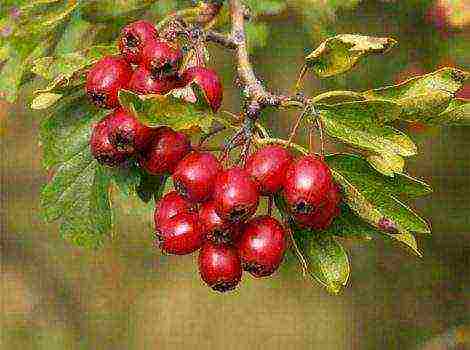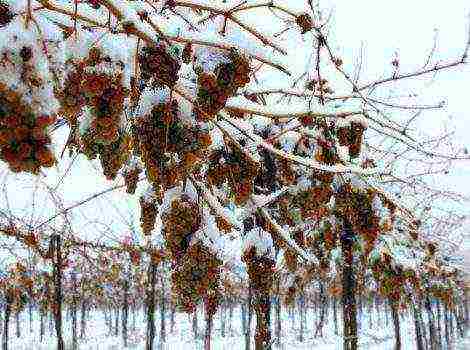Content
- 1 Juicy peach variety
- 2 Varieties and their description
- 3 Self-fertilized, self-fertile peaches: Inka, Vulcan, Harnas, Golden Jubilee
- 4 Groups of varieties
- 5 The best varieties and their description
- 6 Peach planting care type description
The flowering of peach orchards in the Piedmont Crimea is a real miracle, delighting few tourists at the turn of March and April. However, in some years the peach blooms in winter, even on New Years. The modern variety of varieties of different ripening periods makes the flowering season quite long. It should be emphasized that for active types of tourism, the end of March is already a full-fledged luxury season in all respects.
For household plots and summer cottages, it is important that peach seedlings can be planted from the time of the February thaws until the May holidays. However, one must understand that with early varieties, there is a high risk of frost damage to flowering trees. So it is better to buy at least three seedlings of different ripening periods, be sure to medium and late.
The botanical name of the peach - Prunus persica - literally means "Persian plum". In Europe and in the world, the spread of the peach culture came from Persia. In the countries of the former Soviet Union, the best peach varieties grow in the Transcaucasia, Crimea, Dagestan and Central Asia. Currently, world peach production is mainly concentrated in Europe (Italy, France, Bulgaria, Spain), North America (USA, Mexico, Canada) and Latin (Argentina, Brazil). It is grown in smaller quantities in Turkey, Japan, Australia, Morocco. It is believed that the native land of the peach is North China, since in the vicinity of Beijing botanists described the species Prunus Davidiana Franchet very close to the cultivated peach.
True, many realities of the peach culture are not clear at the same time:
1. By fruit, there are 4 classes of peach:
- a) velvety fruits, the pulp is easily separated from the stone: real peaches (peches);
- b) the fruits are velvety, the pulp does not separate from the stone: pavies;
- c) the fruits are bare, the pulp is easily separated from the stone: nectarines;
- d) naked fruits, the stone does not separate from the pulp: brugnons, violettes.
2. With regard to nectarines, it is quite possible to believe that they are close to plums. Probably, a blackthorn or cherry plum may well grow from a nectarine seed. But in Crimea, bitter almonds mainly grow from peach pits, in old (15-20 year old) peach gardens there are always a lot of trees that have run wild and turned into almonds.
The closeness to almonds in white-fleshed peach varieties also proves that with natural splitting of the stone, the peach kernel does not differ much in taste from the almond.
By the color of the pulp, we can say that peaches with white pulp are close to almonds, peaches with red pulp (sanguinoles, cardinales) are close to plums, and those with yellow pulp (apricotees, alberges) are close to apricots. Probably, a wild apricot can grow from the pits of a yellow peach.
However, polymorphism (variety of forms) in general is very typical for all cultivated plants of the rose family, which also includes wild rose, plum, apricot, cherry, apple, pear, hawthorn, mountain ash. In agronomic practice, fruit plants are simply divided into pome (apple, pear, etc.) and stone fruit (apricot, peach, sweet cherry, etc.)
Peaches, in which the stone is easily separated from the pulp, are more often used for compotes and jam, since they are less boiled. It is also important that the skin is easily separated from the pulp, jams and compotes with slices without skin have an unusually delicate taste.
Peach varieties with white flesh tend to be tender and juicy. And in varieties with yellow pulp, the fruits are denser and even gristly. Therefore, varieties with yellow flesh have better transportability and are more suitable for making stewed fruit, jams and other processed products.
Peach pulp contains vitamin PP, carotene, potassium, magnesium, selenium, zinc, and sodium in small amounts. Peach removes excess water from the body, improves intestinal motility and digestion, strengthens the immune system.
Due to their high iron content, peaches are very useful for the prevention and treatment of anemia (anemia) and blood loss from trauma.
Biologically active substances contained in peach fruits contribute to the formation of hemoglobin and red blood cells in the human body, maintain acid-base balance in blood and tissues, increase appetite and help better assimilation of food.
In terms of iron content, peaches surpass many well-known fruits: apples, apricots, pears, plums, persimmons, and 1.5 times - quinces almost 2 times. Peaches contain many vitamins: ascorbic acid - 10 mg / 100 g, flavonoids - 100 mg / 100 g. Essential oil gives them a unique aroma. Some peach varieties contain a large amount of tocopherol, which, together with ascorbic acid and retinol, increases the body's resistance against the development of malignant diseases, as well as against aging.
With a prolonged dry cough, various herbal remedies are used, including peaches, which in any form have an adaptogenic effect, helping the body to adapt to adverse environmental conditions.
Peaches are recommended to improve appetite. They enhance the secretory activity of the digestive glands, improve the digestion of fatty foods, and therefore serve them for dessert.
Peach and nectarine varieties, which contain small amounts of sugar, can be used in food by patients with gout and diabetes. Peach juice is useful for heart rhythm disturbances, anemia, stomach diseases with low acidity, and stomach congestion.
Peach pulp is also used for cosmetic purposes: masks made from it give the skin velvety, freshness and elasticity.
In addition, it is very useful for maintaining the female reproductive system, as well as for depression and anemia, its use relieves swelling.
However, you should be careful not to eat fruits with a split stone, as it contains hydrocyanic acid, albeit in small doses. The content of hydrocyanic acid is minimal if the stone has a sweet kernel flavor (in fact, does not differ from almonds).
Peaches are good for heart disease. Potassium, contained in abundance in them, improves the metabolism of carbohydrates in the body, and if it is lacking, cardiac activity may be impaired.
It is most useful to use fresh peach, boiled, it loses some of its healing properties.
The highest healing power of a peach is if there are fruits that ripen directly on the tree and naturally fall to the ground. True, for this you need to be near the peach trees for some time and have full guarantees that the fruits are not processed with pesticides. In many private boarding houses of the Crimea it is quite possible.
Comparative nutritional value of peach
Product! Proteins, g! Fats, g! Carbohydrates, g! Calorie content, kcal
Apricots 0.9 0.0 10.5 45
Pineapple 0.4 0.0 11.8 48
Watermelons 0.5 0.2 6.0 27
Bananas 1.5 0.0 22.0 94
Grapes 1.0 1.0 18.0 85
Peaches 0.6 0.0 16.0 66
Peach is a fast-growing and high-yielding crop. Grafted plants, when planted in a permanent place, begin to bear fruit in the 3rd year, grown from seeds - in the 3-5th, and when planted with seeds in a permanent place - in the 3-4th year. From one tree, you can get 30-100 kg of fruit. The lifespan of peach trees is short: grafted 1 5-20 years, seedlings 25-30 years. However, the high yield and value of the fruit makes this crop highly profitable in production plantings. Peach varieties for various purposes: table, canning, for cooking dried fruits.
Peach is the leading stone fruit crop in the gardens of the Piedmont Crimea, it is also abundant in Central Crimea, and the best peaches ripen on Tarkhankut in the village. Olenevka.
Peach trees in Crimea are undersized, and therefore suffer greatly from frosts, cold spring mountain-valley winds. On soils with close occurrence of limestones, trees live only 5-10 years. Therefore, the best peaches grow in areas with light sandy soils and good protection from northeasterly winds. The lower parts of the valleys of the Bakhchisarai region near the western coast of Crimea (the villages of Andreevka, Uglovoe, Peschanoe, Beregovoe, Nikolaevka), as well as the coastal villages of the Saki region and the eastern part of the Kazantip bay (Nizhnezamorskoe, Novootradnoe, Zolotoe) provide excellent opportunities for vacationers to taste juicy fragrant fruits straight from the tree.
The main merit in the distribution of the peach belongs to the Nikitsky Garden: before the annexation of Crimea to Russia, the peach culture did not develop for many reasons (budding was not used, the export and storage of perishable fruits was impossible), therefore, it is impossible to name a single high-quality native variety.
Only in the foothill zone, 15 table and 5 canned varieties are zoned, which creates a good filling of counters with fresh fruits within 2 months and all year round - compotes, jams, mashed potatoes, juices. The variety of peach varieties in the markets is naturally even higher. Good quality can be noted in peach compotes produced in Greece. High-quality peach fruits are imported to Crimea from Moldova. But peaches from Turkey, like all other fruits, contain too many pesticides and, as a rule, cause allergies.
In addition to breeding Nikitsky Garden, “foreigners” are also successfully grown in Crimea: Veteran (Canada), Golden Jubilee (USA), Redhavin (USA), Favorite Morettini (Italy).
If possible, it is better to eat the fruits that have just been picked from the tree, ripened on it. This is especially true for early varieties. Unripe, hard ("oak"), without blush and aroma, the fruits only shrivel up when they lie and even in compotes will have a mediocre taste. Therefore, buying peaches for export, for 2-3 days of transportation and storage, requires a certain estimate (purely personal), and advice is useless here. Let's say one thing: taste the ripeest and greenest of the batch, think and think.
In the early days, in July, table varieties ripen: Greensboro, Favorita Moretini, Frant, Fluffy early, Juicy, Redhavin.
Greensborough
Early variety from the USA. The tree is medium-sized with a wide-oval crown. Winter hardiness is above average, the variety is partially self-fertile. Fruiting for 3-4 years, annual yield, high.Fruits are medium (110-120 g), round, light yellow with a slight blush. The pulp is white, juicy, taste - 4.2 points. Fruits are transportable, ripen in early August, for universal use.
FLUFFY EARLY
Variety of early ripening period (II decade of July) selected by Nikitsky Botanical Garden. Zoned in Crimea, Kherson, Transcarpathian, Nikolaev and Odessa regions.
Fruits are above average in size (130-150 g), round, creamy basic color with a burgundy marbled blush, occupying up to 50-75% of the surface. The pubescence of the skin is soft, tomentose. The pulp is greenish-white, non-fibrous, very juicy with a moderate aroma, harmonious taste. The stone is medium in size, does not separate from the pulp.
The tree is medium-sized, with an almost spherical crown, with a regular and high yield of 50-60 kg per tree. Winter hardiness of fruit buds is high. Flowering of the middle period. Flowers are pink.
JUICY
Variety of early ripening (1st decade of August) bred by Nikitsky Botanical Garden. Zoned in Crimea, Zaporozhye, Odessa, Nikolaev and Vinnitsa regions.
Fruits are large (150-200 g), round, creamy basic color with blurry carmine and in the form of thicker streaks and streaks of blush, occupying up to 75-100% of the surface. The pubescence of the skin is velvety. The pulp is greenish-creamy, non-fibrous, very juicy, highly aromatic, with a substantial taste. The stone is medium in size, it separates from the pulp impure.
The trees are vigorous, with a wide, densely branched crown, with a regular and high yield - 55-60 kg per tree. Winter hardiness of fruit buds is high. Flowering of the middle period. Flowers are pink-shaped.
REDHAVEN
An early variety for Crimea and an early-middle variety for Ukraine from the USA. The tree is medium-sized with a rounded crown. The variety is quite winter-hardy and resistant to late spring frosts, resistant to curliness, and is affected by fungal diseases. Fruiting in the 4th year, the yield is high (44-110 kg / tree) and regular. Fruits are larger than average (137 g), rounded with pubescence, orange-yellow with a carmine-burgundy blush almost over the entire surface. The pulp is orange-yellow near the stone, pink, tender, juicy, with a strong aroma (taste 4.9 points). The stone is medium, semi-detachable. Fruits ripen in early August, universal use.
FAVORITE
Early variety. The tree is medium-sized with a rounded crown. Productivity is consistently high, average winter hardiness. Bears fruit in the 3rd-4th year. Fruits are medium (80-90 g), round-oval, yellow-green. The pulp is yellow-orange with red veins, juicy, taste 4.5 points. The stone is medium, semi-detachable. The fruits ripen at the end of July, for universal use.
In the early to mid-term (late July - early August) table varieties are ripening: Golden Jubilee, Soviet; canned varieties: Laureate, Ostryakovsky white, Zlatogor.
GOLDEN ANNIVERSARY
Early middle variety from the USA. The tree is medium-sized with a rounded-oval crown, demanding for warmth and light. Low frost resistance, the variety is resistant to powdery mildew, self-fertile. Fruiting for 2-3 years, the annual yield is above average (35-40 kg per tree). Fruits are large (150-170g), oval, golden-yellow with a bright carmine blush, orange-yellow pulp, medium juiciness, taste 4.2 points. The stone is large, freely separates from the pulp. Fruits are transportable, stored for 5-6 days, universal use.
SOVIET
An early-middle variety of Ukrainian selection. Vigorous tree with a spherical crown. The variety is self-fertile, resistant to powdery mildew, average frost resistance. Fruiting for 2-3 years, annual yield, high. Fruits are above average in size (130-150g), oval-round, light yellow with a bright crimson blush on 60% of the surface. The peel is thick with pubescence, it can be easily removed from the fruit. The pulp is yellow, light fibrous, harmonious sweet and sour (4.5 points). The bone is freely separated from the pulp.The fruits ripen in the 2-3 decade of August, it is necessary to remove it in 2-3 doses. Transportability and keeping quality are good, fruits are stored for 6-8 days. A variety for dessert purposes, suitable for processing.
CARDINAL
An early-medium variety from the USA. The tree is medium-sized with a rounded crown. Frost resistance is below average, the variety is resistant to powdery mildew, self-fertile. Fruiting for 2-3 years, annual yield, high (30-35 kg / tree). Fruits are medium (130-140 g), rounded, flattened from the sides, yellow with a carmine blush on 50-60% of the surface. The pulp is yellow, juicy, aromatic (taste 4.8-5 points). The stone is medium, semi-detachable. Fruits ripen at the end of July, transportability is satisfactory.
In the middle (the first-second decade of August) are sang from table varieties - Krasnoschekiy, Kremlevskiy, Veteran, Mayakovskiy, Lola, Krasnaya Devitsa; from canned food - Lebedev.
KRASNOSCHEKY
Variety of average ripening period (II decade of August) selected by Nikitsky Botanical Garden. Zoned in Crimea, Transcarpathian, Vinnytsia and Odessa regions.
The fruits are large (140-160 g), broadly oval, greenish-creamy basic color with a bright crimson blush, occupying up to 25-50% of the surface. The pubescence is medium, soft-clotted. The pulp is greenish-white, non-fibrous, juicy, with a pleasant refreshing taste. The stone is medium in size, it separates well from the pulp.
The trees are medium-sized, with a moderately expanded crown, with a stable high yield - 45-50 kg per tree. Winter hardiness of fruit buds is high. Flowering of the middle period. Flowers are pink-shaped.
Mid-late (end of August) table varieties Tourist and Zolotaya Moskva ripen.
TOURIST
Variety of late ripening (1st decade of September) of the Nikitsky Botanical Garden selection. Zoned in Crimea and Kherson regions.
Fruits are large (150-200 g), broadly oval, almost round, greenish-creamy basic color with burgundy blurred and streaked blush, occupying up to 50% of the fruit surface. The pubescence is weak, suede. The pulp is greenish-white, of medium density, fibrous, juicy, of very good taste with slightly prevailing pleasant acid and high aroma. The stone is large, it separates well from the pulp.
The trees are medium-sized, with a wide reverse-pyramidal crown. Productivity in areas with favorable climatic conditions - 35-40 kg per tree. Winter hardiness of fruit buds is average. Late flowering. Bell-shaped flowers.
GOLDEN MOSCOW
Variety of late ripening (II decade of September) of the Nikitsky Botanical Garden selection. Zoned of the Kherson region.
The fruits are large (150-180 g), rounded, of a bright yellow basic color with a blurry carmine blush, which occupies up to 50-75% of the surface. Pubescence is weak, velvety. The pulp is yellow, solidly fibrous, rather dense, of medium juiciness, with a good aroma, harmoniously rich taste. The stone is medium in size, it separates well from the pulp.
The trees are medium-sized, with a compact crown, almost round in shape, with a regular high yield - 50-55 kg per tree. Winter hardiness of fruit buds is high. Late flowering. The flowers are horn-shaped.
Not everyone likes the fluff that covers the peach; if not washed off properly, it irritates the throat. However, there are unpeeled peaches -nectarines, in appearance and taste, a cross between plum and peach. This also applies to size, taste, and firm pulp, as well as the skin. Mature nectarines are more transportable, although, of course, they lack the tenderness of a real peach.Lola - one of the varieties of nectarine that have recently appeared in the Crimea, and it was bred in Uzbekistan.
NECTARINE KIEVSKY
Variety of medium early ripening, in the first half of August. The yield is high and regular. The tree is weak, with a rounded crown of medium density, requires shaping in the form of a bush with 3 to 4 main branches.Separates fruitfully. The pulp is cartilaginous, juicy, sweet with pleasant acidity, of high taste. The stone is medium, semi-separating from the pulp. Winter hardiness of plants is average.
NECTARINE EUPATORIAN -142
Large, ruddy, without pubescence.
Maturation - medium
Nutrients, vitamins, trace elements - average content per 100 g of peach fruit:
Caloric value: 40.1 kcal
Water: 86.1 g
Proteins: 0.9 g
Fat: 0.1 g
Carbohydrates: 9.5 g
Mono- and disaccharides: 8.3 g
Starch: 1.2 g
Dietary fiber: 2.1 g
Organic acids: 0.7 g
Ash: 0.6 g
Vitamin A: 0.5 mg
Vitamin B1: 0.04 mg
Vitamin B2: 0.08 mg
Vitamin B3: 0.2 mg
Vitamin B6: 0.06 mg
Vitamin B9: 8.0 mcg
Vitamin C: 10.0 mg
Vitamin E: 1.5 mg
Vitamin H: 0.4 μg
Vitamin PP: 0.7 mg
Iron: 0.6 mg
Potassium: 363.0 mg
Calcium: 20.0 mg
Silicon: 10.0 mg
Magnesium: 16.0 mg
Sodium: 30.0 mg
Sulfur: 6.0 mg
Phosphorus: 34.0 mg
Chlorine: 2.0 mg
Aluminum: 650.0 μg
Iodine: 2.0 mcg
Lithium: 3.0 mcg
Manganese: 140.0 mcg
Copper: 50.0 mcg
Nickel: 4.0 mcg
Fluoride: 22.0 μg
Chromium: 14.0 mcg
Zinc: 100.0 mcg
=============
The peach variety BLACK PRINTS ripens in the Crimea in the second decade of August, that is, it has an average ripening period. Beneficial for commercial purposes:
1. Guaranteed sales at a good price during the high season.
2. Good keeping quality and transportability can be guaranteed to holidaymakers that they will be delivered to Siberia in boxes.
3. Suitable for compotes and jam.
4. Black Prince is a trendy peach variety!
5. Medium ripening is not the earliest flowering period. Frost protection.
- Flat ("fig" Fergana) peaches. Fruit quality, purchase and cultivation of seedlings
- Sale of seedlings in Crimea 2016, the best markets and nurseries. Map
- What varieties of fruits, grapes, nuts ripen at the end of July and August, September? High season vegetables and melons
Peach is a short-lived plant... It is distinguished by its rapid entry into the fruiting phase, intensive growth.
Peach buds have the ability to quickly awaken and release young shoots. The crown grows and if it is not thinned out, starting from the second year, then the yield will decrease.
From the fourth year, the peaches will become small and misshapen. Young trees begin to bear fruit in the second year after planting. With good care, they can give a crop in the first year, with autumn planting.
But this should not be allowed. Better to let the plant develop. You will collect a small crop, but time will be spent, and the plant will lose strength.
Table of contents
- Juicy peach variety
- Varieties and their description
- Ripen early: Kiev Early, White Swan, Grisborough and Redhaven, Morettini
- Medium ripening: Collins, Cardinal, Golden Moscow, Sibiryak, Saturn, Kremlin, Donskoy
- Late, frost-resistant: Fury, Frost, Veteran
- Self-fertilized, self-fertile peaches: Inka, Vulcan, Harnas, Golden Jubilee
Juicy peach variety
In the past, gardeners dreamed of peaches that can be grown in all regions of the country, not just in the south.
Today, their dreams have come true: breeders have developed many interesting winter-hardy, frost-resistant varieties with different fruiting times, fruit shapes and taste.
Peach trees are divided into four groups (depending on the shape of the fetus):
- Real peach is a plant with pubescent fruits.
- Nectarine or bare peach.
- Potanin's Peach (Potanin's Almond).
- Fergana peach or fig (flattened fruit).
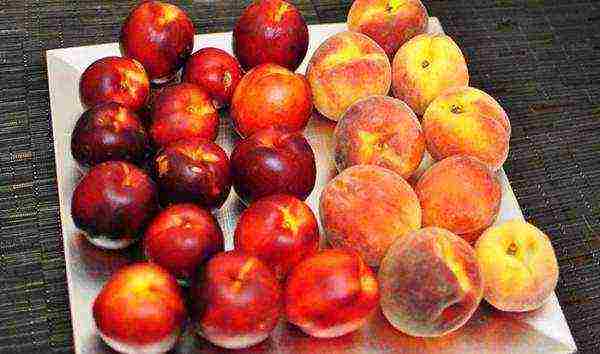 Peach trees are divided into four groups depending on the shape of the fruit.
Peach trees are divided into four groups depending on the shape of the fruit.
The timing of fruit ripening, the flowering period - it all depends not only on the area where the tree is grown, but also on the characteristics of the variety:
- Early maturing varieties give off the first fruits from July to August.
- Mid-season enter the fruiting phase in early August and delight with the harvest until September.
- Late peaches ripen in autumn: September, early October.
Which variety is best suited for a plot or garden depends on the climatic features of the area. It is important to choose plants so as to stretch the fruiting season for the whole season.
The yield of a plant depends on the correct choice of the variety. When buying a seedling, you need to pay attention to several important points, we give their description:
- Where did the seedling come from?... If the nursery is located in a different strip, then the seedling may die in the first year after planting or it will constantly freeze. The variety should be zoned, and the nursery should be in the same climatic zone (preferably even in the same region) where the tree will grow.
- Inspection of the scion site... It should be smooth and even, without bumps and hardened juice.
- Plant root system should have a fibrous shape. A root in one trunk is not good.
Annual seedlings take root better and delight with the harvest faster. When buying, it is better to focus on them, but choose strong, healthy plants, and not frail twigs.
Varieties and their description
Ripen early: Kiev Early, White Swan, Grisborough and Redhaven, Morettini
The peculiarity of early maturing varieties is that they quickly enter the fruiting phase. Two-, three-year-old seedlings are already producing a small harvest. Yields peak in the fourth to fifth year after planting.
When choosing early maturing varieties, it is better to focus on plants that have a low, spreading crown. They are easier to care for and shape during the growth period. Shorter trees are also easier to harvest.
Among the representatives of this group, varieties deserve special attention Kiev Early, White Swan and Redhaven.
Redhiven's crop peaks at 11 years of age. More than a hundred kilograms of fruit are harvested from one tree.
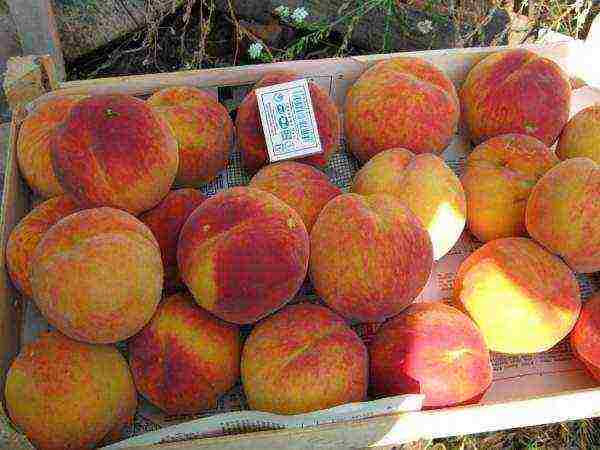 The best early varieties of peaches: Kievsky Early, White Swan, Grisborough and Redhaven, Morettini
The best early varieties of peaches: Kievsky Early, White Swan, Grisborough and Redhaven, Morettini
Each variety of early peach is good in its own way and has a lot of advantages.
Benefits of early peach varieties:
- form a wide crown no more than 5 meters high;
- plants bloom in April-May;
- they enter the fruiting phase quickly: in the fourth year after planting the seedling;
- fruiting is extended from July to August;
- it has a high yield, aromatic and tasty fruits.
The first fruits appear on a mature, well-formed tree. This cannot but affect the yield: from a six-year-old tree, with proper care, you can harvest up to 60 kilograms of peaches.
Another prominent representative of this group is Grisborough variety... It is distinguished by medium vigor, but, unlike the aforementioned varieties, it has an average winter hardiness.
In order for the plant to bear fruit in mid-latitudes, it must be planted in calm places.
High winter hardiness pleases peach moretini... One of its advantages is a spreading crown that is easy to shape.
Morettini fruits are among the first to ripen, but have average transportability. This prevents the fruit from being transported over long distances.
Medium ripening: Collins, Cardinal, Golden Moscow, Sibiryak, Saturn, Kremlin, Donskoy
Medium ripening varieties allow the peach conveyor to continue.
Feature of plants of this species:
- high, spreading crown (from 5 meters);
- high productivity;
- good winter hardiness;
- large fruits.
Mid-season peaches have a huge number of varieties, but among them there are several types that show themselves perfectly in any conditions and do not require special care: Collins, Cardinal, Golden Moscow, Siberian, Saturn, Kremlin.
Variety Cardinal famous for its huge fruits (from 140 g) and excellent taste. This is one of the most delicious types of peach. On the international tasting scale, he received five points. This is the highest mark.
The plant is resistant to diseases, but it is difficult to tolerate recurrent frosts. It is better to plant it in a calm place, not far from the wall of a house or fence, but away from water.
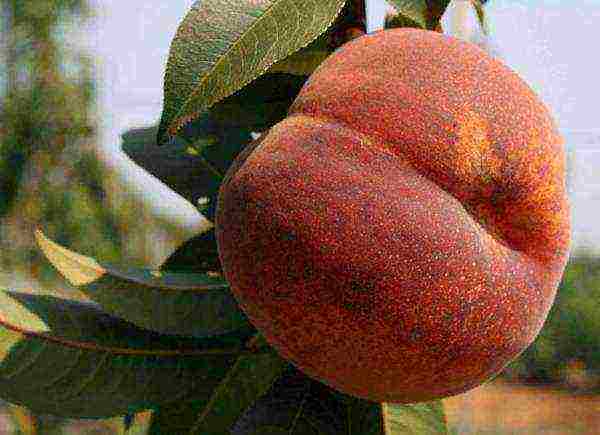 The best varieties of peaches of medium ripening: Collins, Cardinal, Zolotaya Moskva, Sibiryak, Saturn, Kremlevsky, Donskoy
The best varieties of peaches of medium ripening: Collins, Cardinal, Zolotaya Moskva, Sibiryak, Saturn, Kremlevsky, Donskoy
Kremlin peach adapts without problems to changes in temperature conditions, has high winter hardiness.Thanks to this, he attracted the attention of gardeners from regions where summers are cool. With good care, the fruits reach up to 200 g.
Variety Golden Moscow not so long ago appeared on the market, but its seedlings are very popular. The plant winters well and is resistant to diseases, has juicy large fruits.
The fruiting period stretches for almost three weeks. Peach blooms late, after the threat of frost return, and this increases the number of quality fruits.
Sibiryak variety highly regarded by farmers for its excellent transportability. The yellow fruit can be stored in a cold room for up to three weeks. In addition, they are tasty and juicy, and the bone is easily separated from the pulp.
The first crop is harvested in August, and the last fruits are removed in early September.
Peach Saturn stored no longer than 12 days. It's also a lot. The plant has high winter hardiness (up to -27). A strong crown complicates care and this affects the yield.
If the branches are tilted downward, then you can get an excellent harvest every year.
The most winter-hardy representative of this group is peach donskoy... It not only withstands severe frosts, but also quickly recovers after freezing.
The main advantage of peaches of the middle ripening period is high yield, transportability of fruits and excellent winter hardiness of the tree.
Most varieties have a juicy pulp and a pleasant aroma.... A high crown can be regarded as a disadvantage, but with the correct shaping of the tree, it is easily eliminated and turns into a virtue.
Late, frost-resistant: Fury, Frost, Veteran
Planted a peach, but it does not bear fruit, only intensively increases the crown? Do not be upset: it is better to be patient and wait a little longer.
Late-ripening varieties bear fruit starting at the age of 5 after planting a seedling. They are intended for cultivation in the southern regions. In the North and in the Middle zone, they do not have time to ripen and are sour.
American Fury withstands frosts down to -28 degrees. It is valued for its huge, up to 300 g, orange-colored fruits. The plant is undemanding to care.
The collection of fruits falls in September, when only apple and pear trees are left in the garden. The fruits are stored for no longer than six days.
Frost variety also bred by American breeders, who focused on winter hardiness and large-fruited plants.
The tree gives a high stable yield, withstands frosts down to -26 degrees, and is resistant to diseases. The fruits are used for fresh food. Stored for ten days.
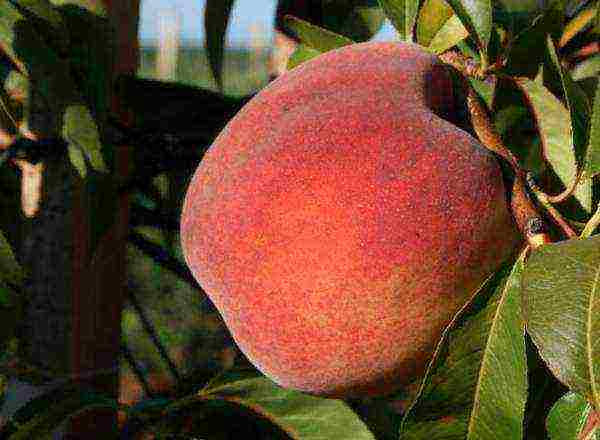 The best late-ripening peach varieties: Fury, Frost, Veteran
The best late-ripening peach varieties: Fury, Frost, Veteran
Veteran grade differs from late-ripening varieties in that it quickly enters the fruiting phase and has a low growth. The size of the fruit is also not impressive (no more than 150 g).
They love it for its good taste. It is ideal for conservation.
Self-fertilized, self-fertile peaches: Inka, Vulcan, Harnas, Golden Jubilee
Self-pollinated varieties are very popular among gardeners. To increase fruiting, it is recommended to plant several plants for cross-pollination... But one tree will also bear fruit.
Among self-pollinated, self-fertile varieties, a good harvest in a single planting gives Inka, Volcano, Harnas, Golden Jubilee.
Harnas belongs to winter-hardy, early-ripening dessert varieties. It is a vigorous tree that bears fruit regularly. Its peculiarity is that the fruits hold tightly to the branches and do not fall off.
Early maturing varieties are distinguished by high winter hardiness of trees and flower buds. They can withstand recurrent frosts. This makes it possible to grow them not only in the southern latitudes, but also in the middle lane, as well as in Siberia and the Urals.
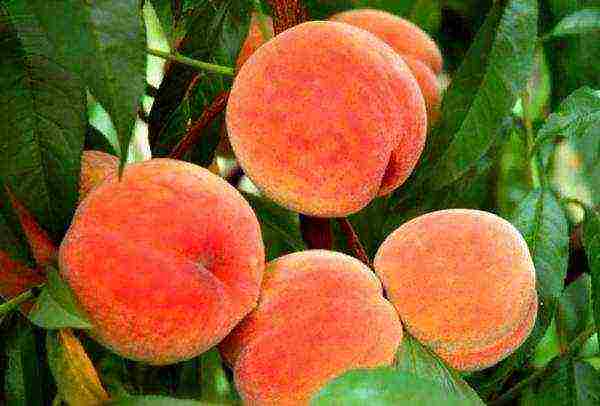 Self-pollinated peach varieties: Inka, Volcano, Harnas, Golden Jubilee
Self-pollinated peach varieties: Inka, Volcano, Harnas, Golden Jubilee
In the regions of Siberia, it is necessary to protect trees from recurrent frosts.
Mid-season varieties build up a decent crown and only then please with a rich harvest. The disadvantage is that it is difficult to form branches, but a regular and generous harvest allows you to turn a blind eye to this.
Mid-season varieties often bent downward to facilitate harvesting.
The lack of late-ripening varieties isthat they can only grow in a certain area. But if climatic conditions allow, then these trees will not only decorate the garden, but also delight you with delicious fruits.
When planting a peach, it should be borne in mind that all varieties bloom very early, when there are still few pollinating insects. You can help the plant by gently shaking the upper branches so that the pollen falls on the lower inflorescences.
Plants respond well to fertilizing and watering... Water plays an important role in the formation of fruits. Its quantity depends not only on the size of peaches, but also on their taste and aroma.
Give your seedlings a little attention and care so that they can turn into beautiful trees and please with the harvest every year.
Gardeners have always strived to grow these juicy, tasty fruits in all regions. The best varieties of peaches have already been bred, corresponding to the annual temperatures of many regions, but breeding work continues and discoveries with new incredible properties await us.
Groups of varieties
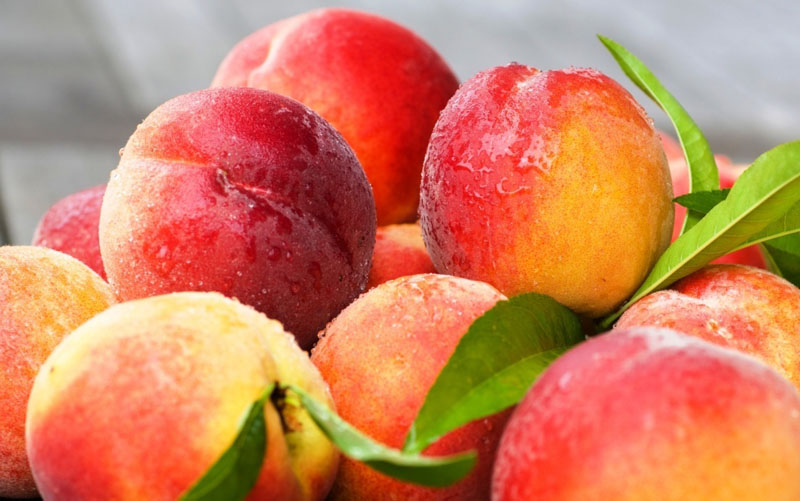
The varieties known today, depending on the appearance of the fruit, are divided into four groups:
- Real peach - large fruits of a round shape with pronounced pubescence.
- Nectarine - round, medium-sized, smooth-skinned fruits.
- Potanin's peach - Potanin's almonds. Round, medium-sized pubescent fruits.
- Fergana peach - another name for "fig" because of the flattened shape of the fluffy fruits.
Also, peach trees are distinguished by their ripening times, which depend both on the area and on the variety:
- Early ripe- ripen in late June, early July and bear fruit until August.
- Mid-season - begin to yield crops from early August to September.
- Late ripening- ripen in September, early October.
The choice of plants for the garden should be based on climatic conditions and personal needs. You can concentrate the entire crop in a short time interval, but it is better, by picking up varieties, to collect juicy hairy fruits all summer and autumn.
A good harvest depends not only on the grade, but also on other features that should be considered when choosing seedlings.
- Geography.The nursery from which the seedling arrived must be located in the same climatic zone in which it is planned to grow. Otherwise, diseases and other problems of adaptation are inevitable.
- Quality scion... This is evidenced by an even, smooth place of the scion without sap drips and tubercles.
- A viable root system. One root will not provide the plant with good nutrition. It is better to choose a seedling with a developed fibrous root shape.
When buying seedlings, you should choose annual, healthy and strong plants: they take root well and quickly begin to bear fruit.
The best varieties and their description
Peach trees differ in fruit shape, ripening times and frost resistance.
Early ripe
The peculiarity of these varieties is in the rapid transition to fruiting. The peak yield occurs 4-5 years after rooting, but a small amount of fruits ripens already on 2-3 year old trees. Some plants pick up ovaries even in the first year of planting, but it is better to stop this, the plant needs to get stronger.
Distinctive features of early peach varieties:
- low wide crown;
- flowering in April - May;
- they begin to bear fruit in the fourth year after planting the seedling;
- high yield for 3 months, from July to August;
Each early variety is good in its own way and has features that you need to know when choosing peaches for your site.
Fluffy early
Photo:
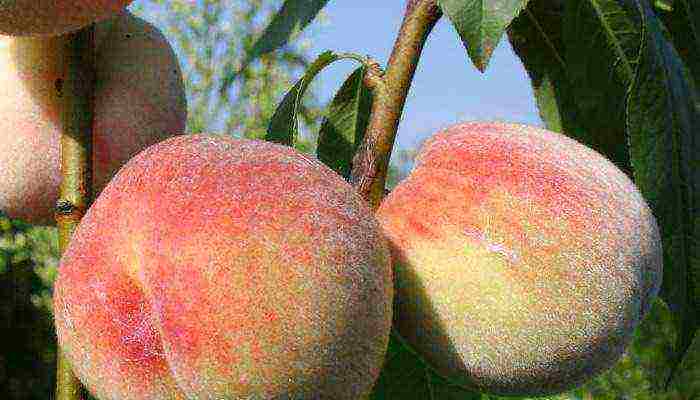
Self-fertile variety with high yields, most suitable for growing in regions climatically similar to the North Caucasus. On trees of medium height, oval-round fruits (up to 100 g) with a barely noticeable seam ripen.
The soft greenish-creamy skin is densely pubescent and covered with a coral blush. Delicate white pulp is filled with sweet juice and a unique aroma. The variety is quite resistant to frost and pests.
Greensboro
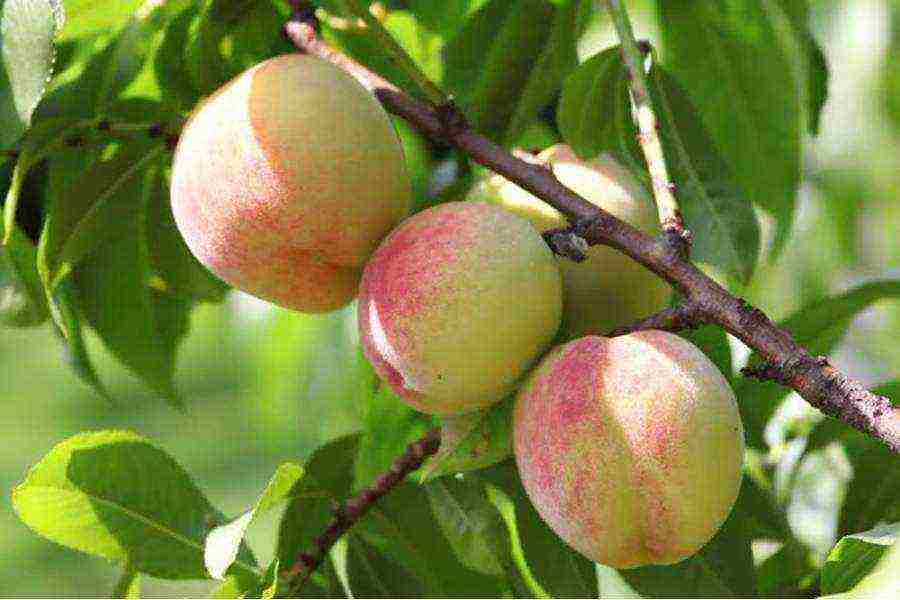
Bred by American breeders. The spreading crown of a vigorous tree gives a large yield of large (up to 120 g) oval-flattened fruits with a refreshing sweet-sour taste and a pleasant aroma of creamy fibrous pulp.
The thick golden-greenish skin is covered with rare burgundy touches. Similar to the Early Fluffy, grows well in the North Caucasian region, frost-resistant, immune to clasterosporium disease. For mid-latitude cultivation, it is recommended to choose windless areas.
Dagestan gold
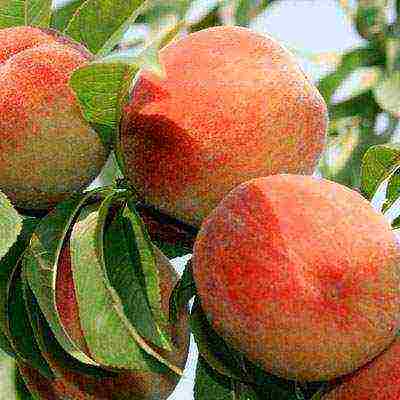
Bred by domestic breeders for Dagestan agriculture. The variety has a stable yield, a spherical crown of a medium-sized tree.
Medium-sized fruits (up to 130 g) have a slightly pubescent saffron skin with a bright blush and an orange-golden, fibrous texture, pulp with a memorable sweet-sour taste and aroma. The plant is frost-resistant, immune to clasterosporium disease and curliness; fruits tolerate transportation well.
Favorite Morettini
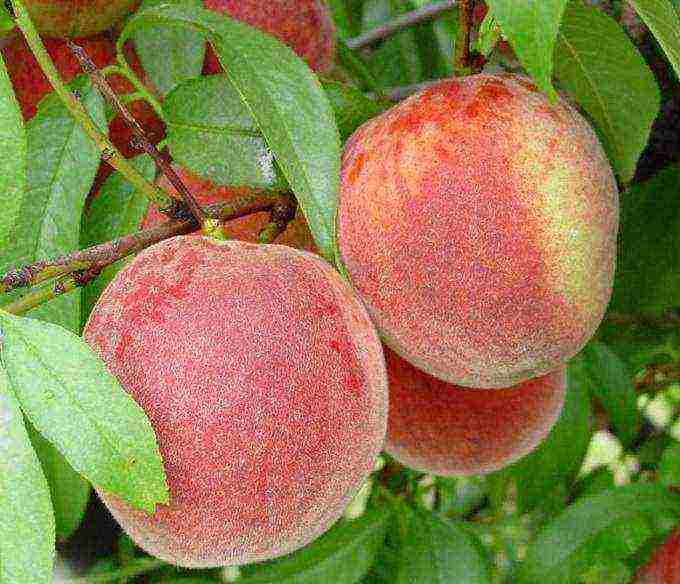
The work of Italian scientists. It is characterized by very early ripening and an unusual growth rate of shoots (up to 0.5 m per season). Fruits with juicy, melting in the mouth, pulp reach 150 g with an average yield of about 40 kg per tree. The variety is quite resistant to diseases, but does not tolerate frost well.
However, gardeners argue that if the roots of the plant are properly covered for the winter, then it can be grown much further north. Only transported over short distances.
Kiev early

Fruits, ripening in early July, grow up to 100 g and have a sweet, fragrant white pulp. The variety is non-frost-resistant, but a peculiarity is noticed behind it: after a cold injury, recover in a year or two. Also, susceptibility to powdery mildew is high, although work is underway in this direction to improve varietal characteristics.
White Swan
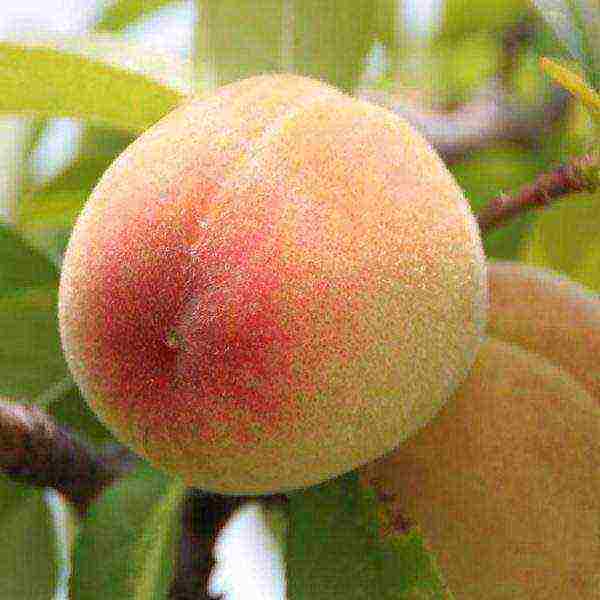
Medium early self-fertile variety with a spherical, not very spreading crown. Fruits up to 155 g, with a creamy-white juicy pulp that does not darken on the cut. The pleasant harmonious taste is suitable both for fresh consumption and for various types of processing. High-yielding, disease and drought resistant variety, most suitable for central Russia.
Medium ripening peaches
For early maturing, the baton is picked up by varieties with an average ripening period.
Distinctive features of these plants:
- a high trunk with an extensive crown, above 5 meters;
- high productivity;
- frost resistance;
- large fruits.
Many varieties of peaches with medium ripening periods have been bred, among which the favorites stand out: Redhaven, Golden Jubilee, Stavropol Pink, Ambassador of Peace, Hryvnia, Veteran, Ruby Prince, Fig Peach Saturn, Vladimir, Cardinal, Kremlin, Golden Moscow, Sibiryak, Donskoy. They are generally unpretentious and require minimal maintenance.
From peach trees with an average ripening period, the first ripe fruits can be harvested 3-4 months after flowering.
Redhaven
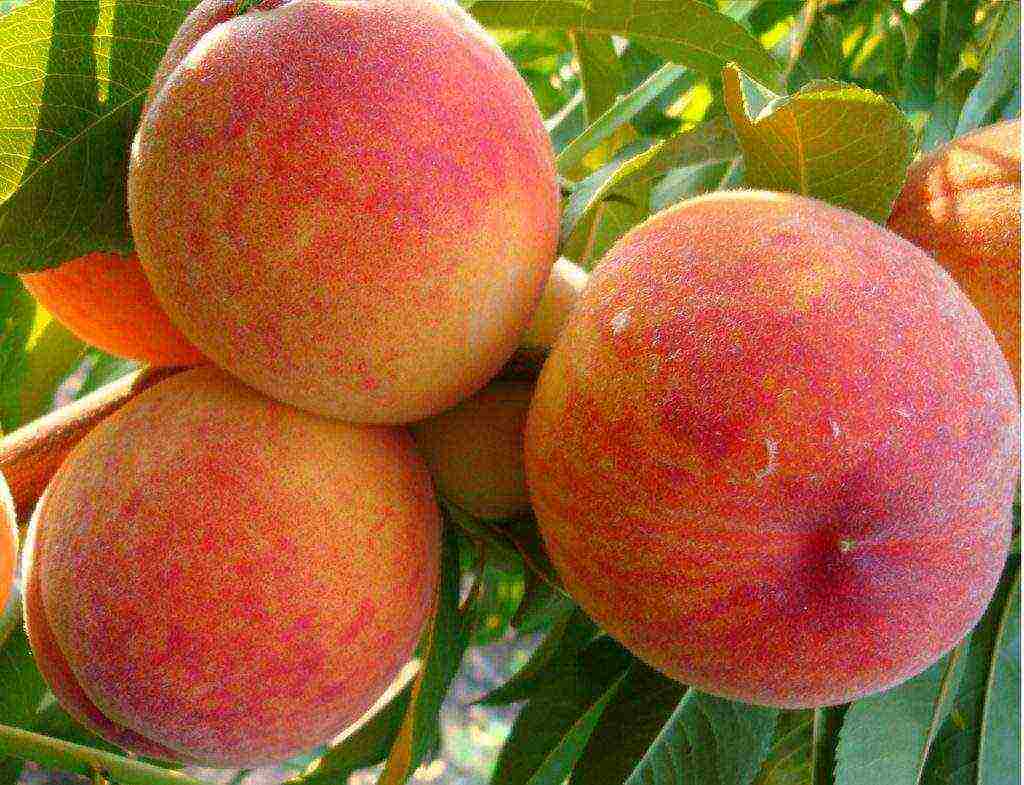
Bred in America. A high-yielding variety with large fruits (up to 170 g), rounded-elongated, golden in color with pomegranate sides and light down. Juicy pale orange, with raspberry veins, the pulp is tasty both fresh and canned. Begins to bear fruit in early August, tolerates drought well, but is moderately resistant to frost and diseases.
Golden jubilee

Also American selection.Stably productive variety with spherical large fruits (up to 140 g), covered with golden, thin, slightly pubescent skin with a coral blush. Bright orange fibrous pulp, which turns into cherry at the stone, has a pleasant sweet taste. Resistant to frost and fungal diseases, recommended for the North Caucasus region.
Stavropol pink

High-yielding variety of domestic selection. Derived for the climatic conditions of the foothill and central regions of the Stavropol Territory. Large fruits (up to 140 g) ripen from mid-August and have a delicate pulp with an extraordinary sweet and sour taste with a velvety golden-ruddy skin.
The plant prefers light soils enriched with humus with good moisture, heating and ventilation. It does not tolerate dry seasons, but it is resistant to frost and disease.
Ambassador of Peace
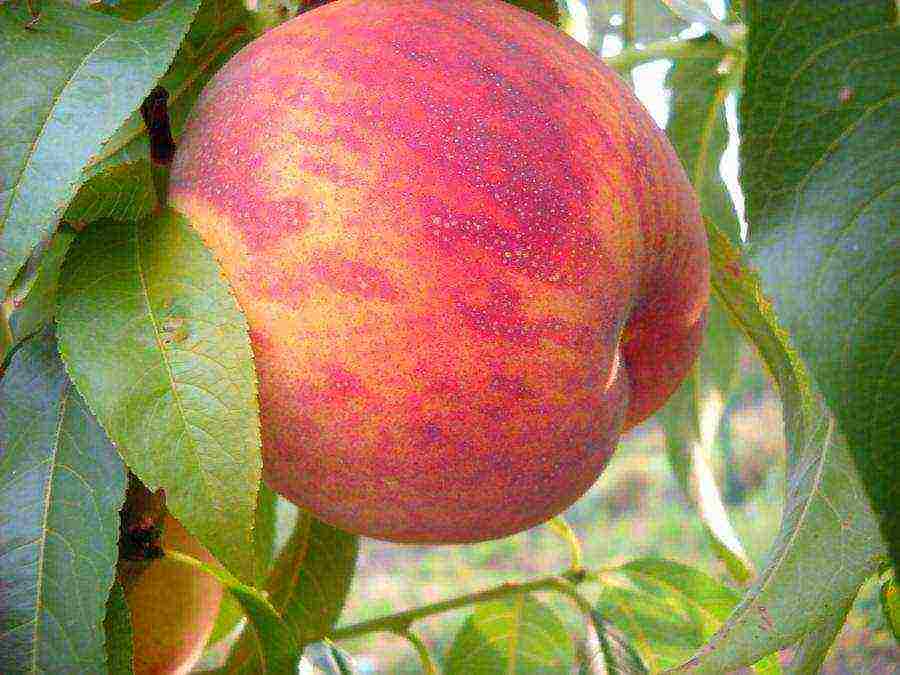
A young high-yielding variety, with large (up to 160 g) saffron-colored fruits with a bright blush and juicy sweet pulp. Resistant to spring frost and fungal diseases.
Hryvnia
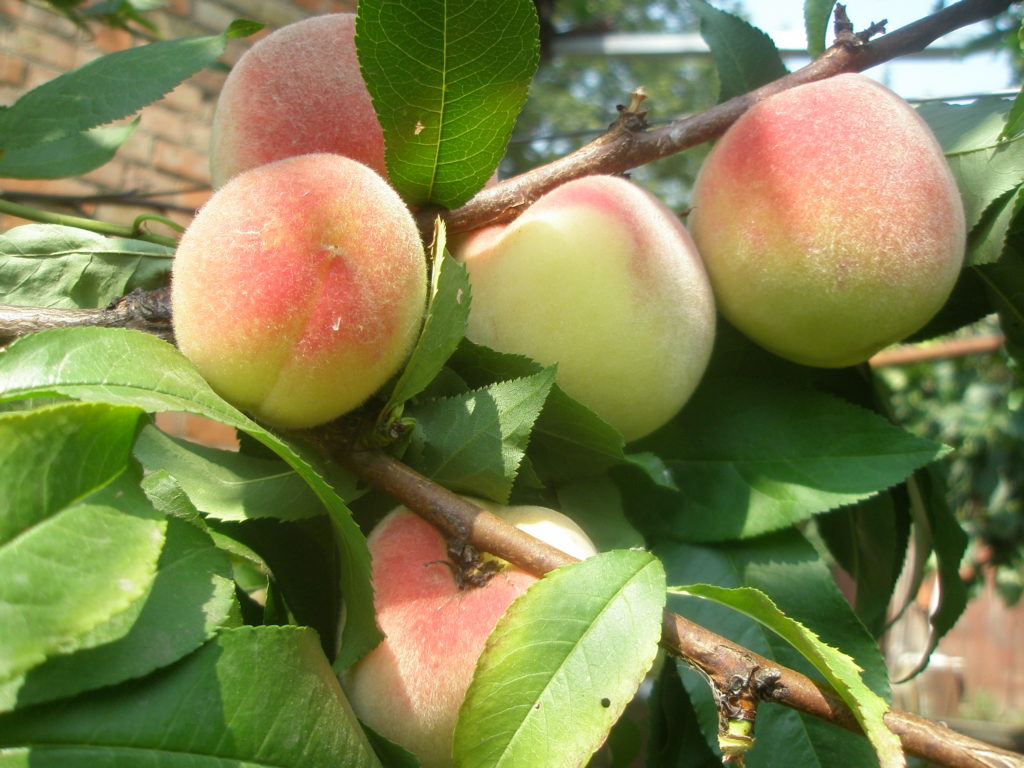
A promising hybrid variety. Small (up to 90 g) fruits begin to ripen in the first decade of September, 2-3 years after planting. Yellow, covered with fluff and striped-blurred blush, fruits with aromatic juicy pulp tolerate transportation well. Winter hardy, resistant to powdery mildew and curliness.
Veteran

Canadian selection in 1925. High-yielding and very hardy. The first large fruits (up to 130 g) begin to ripen 3 years after planting, have excellent taste, good transportability and disease resistance. Thanks to such varieties, gardeners in regions with cold climates have the opportunity to grow this traditional southern fruit.
Ruby Prince
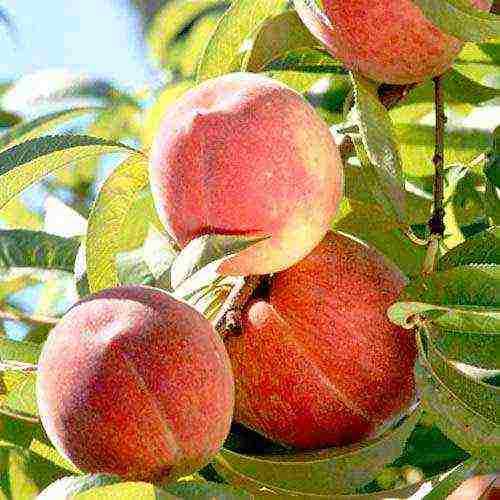
A variety of American selection. The name of the variety speaks for itself: a high yield of fleshy, juicy, large (up to 300 g) fruits with bright yellow pulp and sweet and sour taste, begins to ripen in the second half of July. This variety is commercially attractive due to its good transportability and long-term retention of presentation.
Fig peach
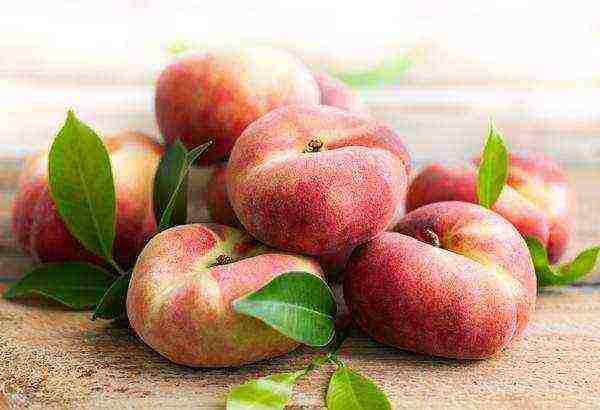
A relatively young form. It entered Europe at the beginning of the 19th century, but did not receive wide distribution, although its qualities are in no way inferior to the usual varieties.
High-yield, frost-resistant, with a small bone and flattened fruits, varieties are compactly packed and perfectly transported, but not endowed with long-term storage.
The most popular varieties are: Vladimir and Saturn. The first is characterized by large bright fruits (up to 180 g) with juicy sweet pulp, the second has medium-sized fruits (up to 100 g), cream color with white fragrant sweet pulp, which changes the taste near the stone.
Cardinal
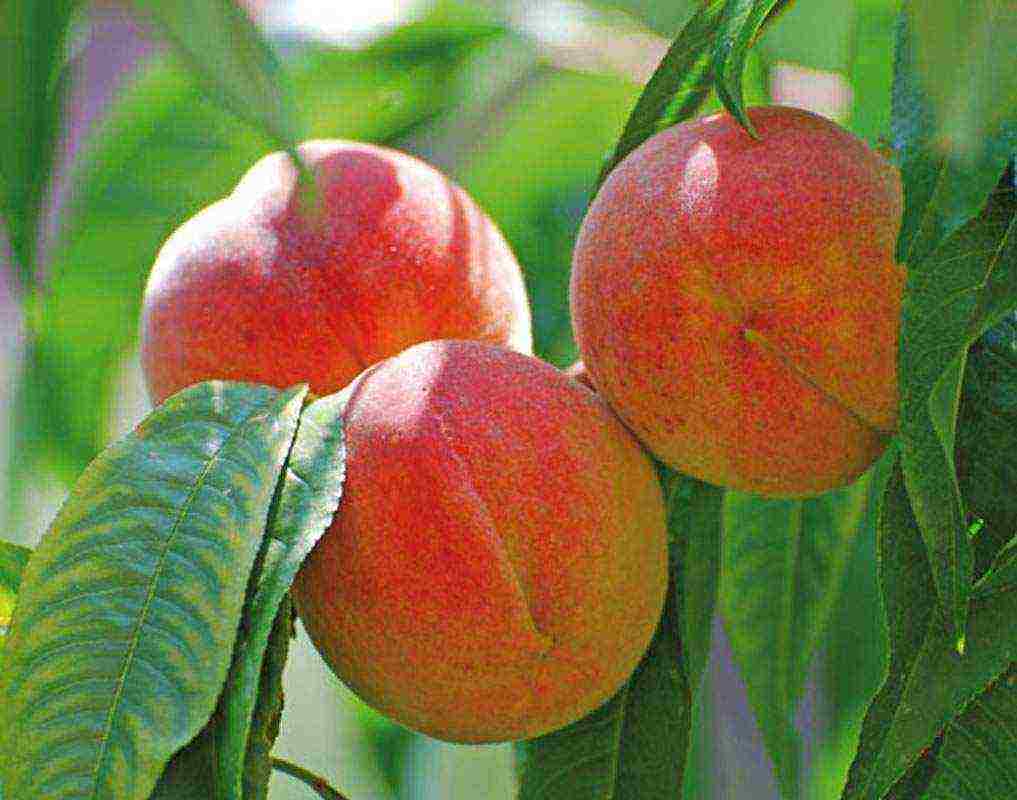
One of the best varieties in terms of taste. On the international tasting scale, he won the highest mark - 5 points. Large fruits (up to 150 g) of a rounded slightly flattened shape with an orange-yellow pulp and a characteristic blush. It is resistant to diseases, but does not tolerate recurrent frosts. It is better to plant it away from water, in a calm place, next to a wall or fence.
Kremlin peach

Domestic selection. Easily adapts to any soil and weather conditions, resistant to frost, drought and disease. Large fruits (up to 200 g) with an average juiciness and a pronounced peach aroma are covered with a yellowish-orange skin with a red blush. Recommended for regions with cool climates.
Golden Moscow
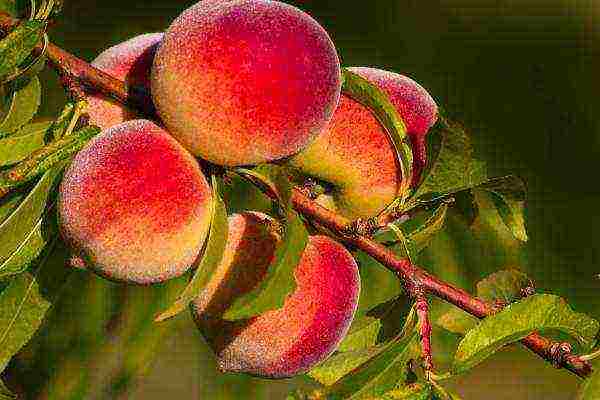
Bred in the Nikitsky Botanical Garden. Large fruits (up to 180 g) of broadly oval shape with dots, strokes and slight pubescence on ripe ruddy fruits. Sweet pleasant taste with mild sourness, estimated at 4.8 points. Due to late flowering, it is not affected by return frosts, which increases productivity.
Siberian
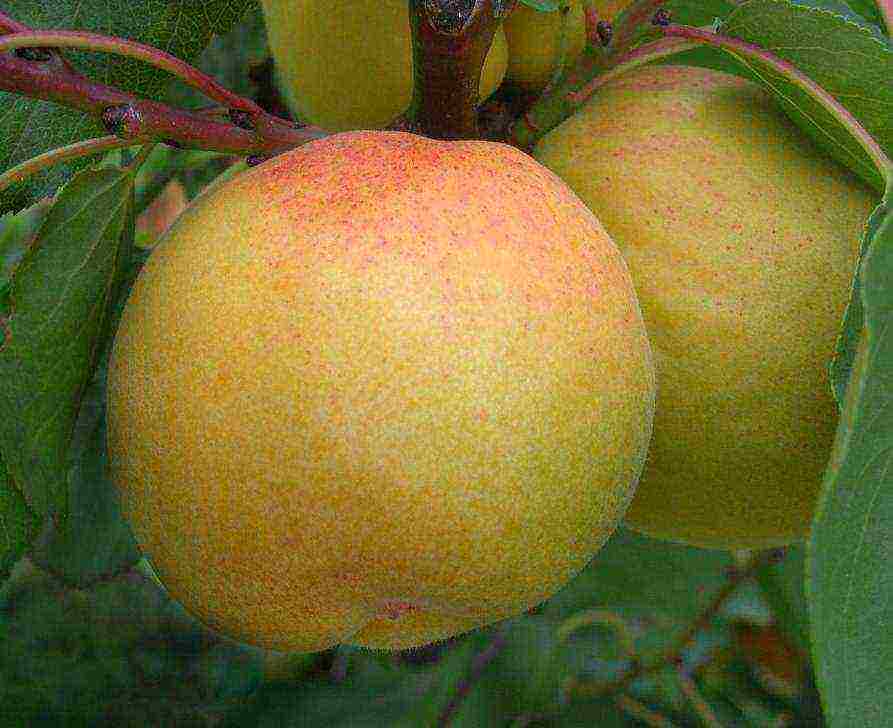
Created by specialists of the Nikitsky Botanical Garden.It is highly valued for its long shelf life, good transportability and disease resistance. Fruits up to 130 g in size have a juicy, yellowish, dense fibrous, sweet pulp. The pubescent yellow skin is covered with a bright blush on the sunny side.
Donskoy
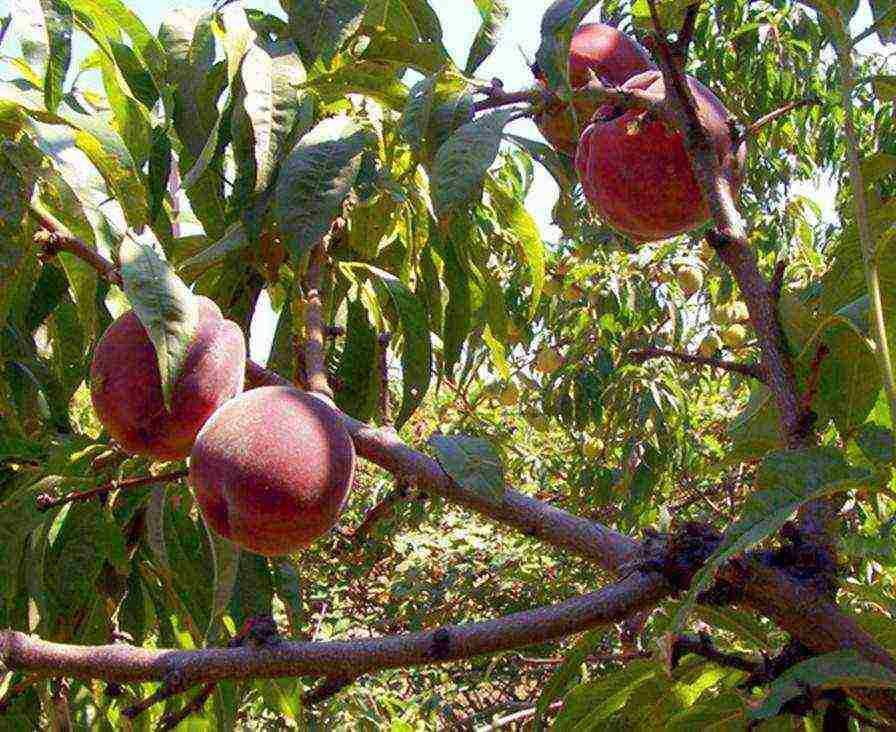
The most frost-resistant variety in this group. Even after severe frost, it retains the ability to recover. The fruit with a transparent, white, dense pulp, sweet taste with a slight pleasant sourness, is estimated by tasters at 4.5-4.6 points. Disease resistant.
The main advantages of peaches of the middle ripening period are high yields, transportability and cold resistance.
The best varieties of late, frost-resistant peaches
Far-sighted gardeners prefer late varieties with exceptional taste and long shelf life.
Late-ripening varieties begin to bear fruit by the fifth year after planting the seedling. They were bred for cultivation in the southern regions. In the Central lane and in the North, these varieties do not ripen and remain sour.
Jaminat

The work of Dagestani scientists. A fast-growing, medium-late, frost-resistant variety with good immunity, ripening at the end of September. Large (up to 160 g) oval-flattened fruits with bright orange pulp of a delicate pleasant taste in a golden thin skin. Covered with light fluff and streaks of blush.
Elbert
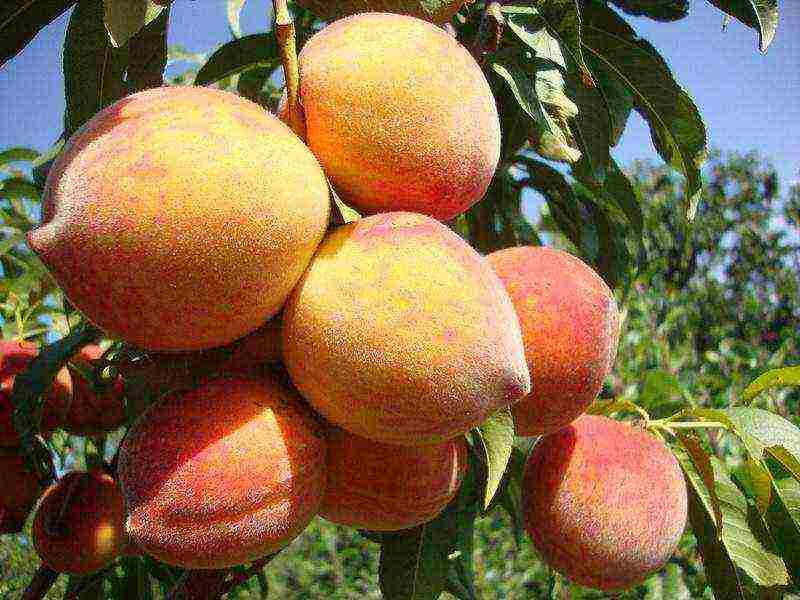
A fast-growing, late-ripening variety of American selection. On vigorous, spreading trees, large (up to 150 g) fruits ripen with a velvety golden-ruddy elegant skin and a fresh sweetish-sour taste. High-yielding, frost-hardy with excellent immune qualities.
Irganai late
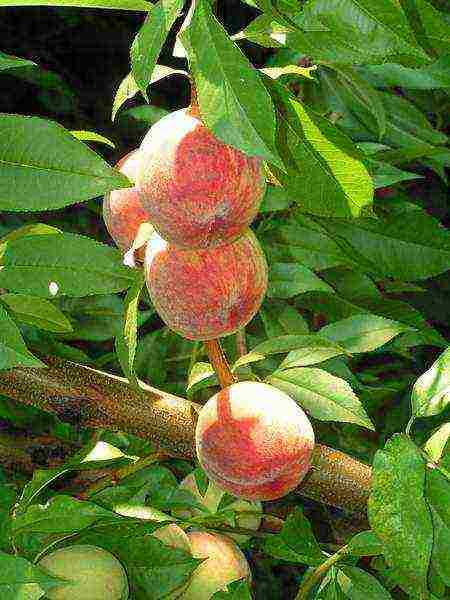
High-yielding variety of Dagestan selection. Large or medium (120-160 g), depending on conditions, one-dimensional fruits ripen by mid-September. The bright yellow delicate sweet-sourish pulp is covered with a thin skin with touches of pomegranate-orange flowers. It is transported without loss, stored for up to 10 days.
Fury
American selection. It tolerates frosts down to -29 ° C, has large (up to 300 g) orange fruits. The tree does not require increased maintenance. The harvest falls in September and is stored for no longer than a week.
Frost
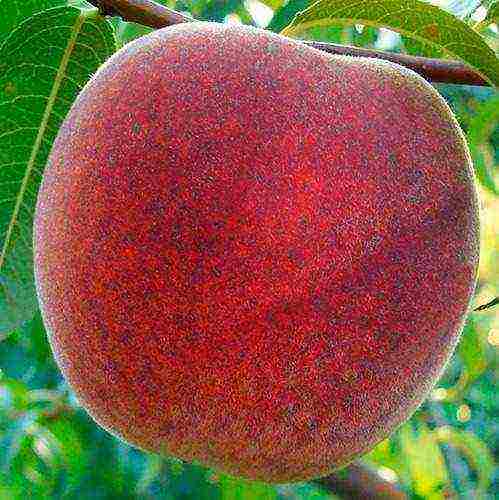
Properties similar to the previous variety. A winter-hardy, large-fruited plant with a consistently high yield and good disease resistance.
Veteran
Drops out of a number of late-ripening varieties for several characteristics:
- fast fruiting phase;
- small growth;
- medium-sized (less than 130 g) fruits.
However, its excellent taste and ideal size for preservation make it a favorite of many gardeners and the food industry.
Champions of frost resistance
The first peach trees were certainly thermophilic. But in recent decades, scientists have developed new varieties for cultivation in cold regions as well.
Now you can buy seedlings of plants that can withstand temperatures down to -30 ° C without significant damage.
Vavilovsky
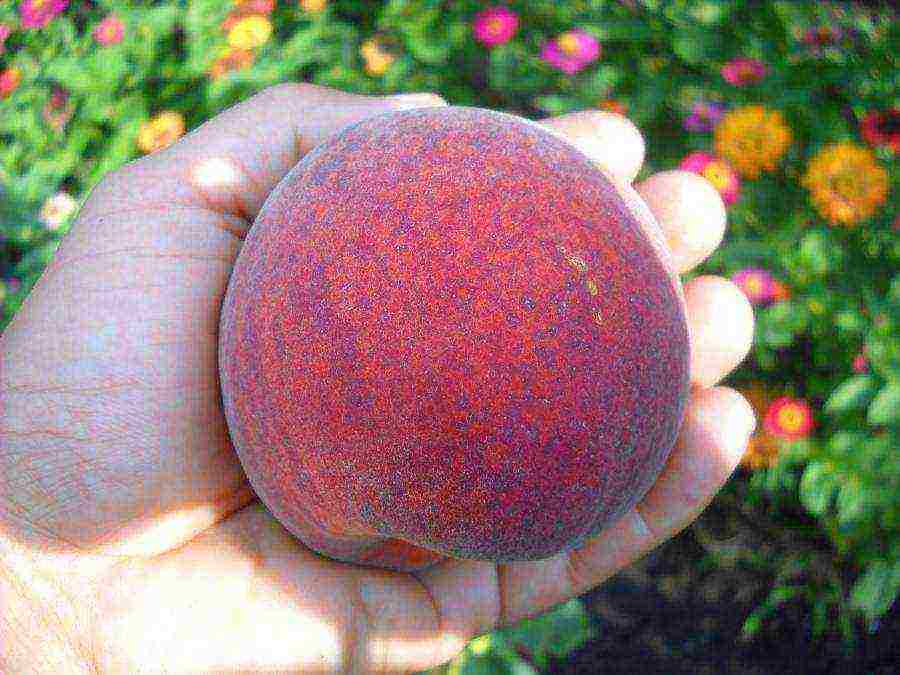
The variety is a mid-early variety of the Crimean selection. It perfectly tolerates low temperatures, return frosts and is resistant to most diseases. The high yield of large (up to 250 g) fruits has an elegant appearance and a pleasant sweet-sour fresh taste.
Fluffy early
The most famous type of domestic selection of this subgroup. Withstands frosts down to -30 ° C, suitable for jams, preserves, canning and fresh consumption.
Juicy
An early frost-resistant species of Russian production. The plant is not afraid of thirty-degree frosts, powdery mildew and curly leaves. Medium (up to 130 g) juicy, fragrant fruits with white pulp and unique taste are so numerous that some have to be removed in the ovary in order to preserve the tree.
Winter hardy
The homeland of the variety is in Ukraine. Withstands freezing down to -40 ° C with subsequent full recovery. A high-yielding variety with large (up to 200 g) tasty sweet fruits.It is recommended to plant at a distance the rest of the stone fruit species.
All peach varieties of this subgroup are bred for cultivation in regions with a short summer and a long cold season.
Self-fertilized, self-fertile peaches
Self-pollinated varieties are very popular among gardeners. To increase yields, it is recommended to plant several plants together, and in calm flowering seasons and in the absence of pollinating insects, use various manual methods of pollination.
But single trees can also please with high fruiting, these include:
- Inca,
- Volcano,
- Harnas,
- Golden jubilee.
In Siberia, these varieties should be protected from recurrent frosts.
Plants respond gratefully to watering and feeding. The availability of sufficient water during the period of fruit formation has a decisive effect on the size, taste and even aroma of the fruit.
Take care of the seedlings, and turning into adult, healthy trees, they will certainly thank you for your attention with a generous, juicy harvest.
Peach planting care type description
The combination of subtle peach aroma, high nutritional value of the pulp and refreshing taste makes them a valuable food product for humans.
Along with fresh consumption, peach fruits are widely used in the canning and confectionery industry for the preparation of jam, candied fruit, jam, marmalade, preserves, compotes, soft drinks and wine. The oil obtained from its seeds is equivalent to almond oil. Some varieties of sweet seeds serve as a substitute for almonds.
Peach has a number of valuable agrobiological properties. This is one of the fastest growing fruit crops. Many varieties begin to bear fruit in the second and third years after planting. The productive period of a tree is 18-20 years.
The peach blooms later than the apricot and almond, which significantly reduces the possibility of damage to it by spring frosts.
The content of the article
Description of peach groups ... Peach flowering time ... Peach hardiness ... Peach fruiting beginning ... Peach diseases and resistant varieties ... Peach agronomic features ... Peach care ... Peach pruning ...
Under favorable growing conditions, peach trees are distinguished by regular and high productivity, with an average yield of 12-16 tons per hectare (when planting 5X5 m), trees of many varieties at 15 years of age give from 70-100 to 200-250 kg.
A valuable property is a wide variety of varieties varying in terms of fruit ripening from the first decade of July to the first decade of October.
Peach is a heat-loving and drought-resistant plant. In terms of frost resistance, its wood is equated to the wood of the southern varieties of apple and pear. Fruit buds are less hardy, may die at -24. Due to their good compatibility with various rootstocks (almond, peach, cherry plum, apricot, thorn), peach trees are highly adaptable to a variety of soil conditions.
All of the above qualities, including the relatively small size of the tree, make it an indispensable crop both in clean plantings and for compacting highly vigorous, late fruiting, durable species.
A peach is very valuable for planting in personal plots.
In the south of our country, peach trees make up 2.67% of the total number of fruit trees and 14.17% of stone fruit crops. The bulk of the plantings are located in the southern coastal zone.
As the experience of individual farms shows, the peach also feels good in the foothill zone and in some steppe regions.
In connection with the expansion of the network of resorts, the prospects for the development of peach in Crimea are not limited. In addition to the South Coast, where it should take the main place in industrial gardens, peach can be widely planted as a compactor and in clean plantings in the foothill, eastern and western steppe zones.Certain varieties (Fluffy early, Juicy, Red-cheeked, Otechestvenny, Amsden) can serve as the basis for laying gardens in the southern part of the central steppe zone.
The peach belongs to the genus Persica (Mill.), The pink-flowering family (Rosaceae), the stone fruit subfamily (Drupaceae).
The following types of peach are best known: common peach - P. vulgaris (Mill.), David's peach - P. Davidia-na (Carr.) And Fergana peach - P. ferganensis (Kost, et Riab.) Most of the cultivated varieties (over 3000) belong to the common peach.
The distribution area of the cultivated peach is very large - from 50 degrees north latitude from 35-40 south. The peach is found in height up to 3000 m above sea level. Over the millennia, different ecological conditions of the places of growth have led to the formation of sharply isolated varietal ecological groups, characterized by a certain complex of agrobotanical traits and a common origin. IN Ryabov distinguishes four groups in his classification: Fergana, North Chinese, South Chinese and Iranian.
Description of peach groups
Fergana peach group: characterized by a peculiar venation of leaves with a sharp release of lateral veins to the very edge of the plate. The bone has a parallel-ribbed irregularity. Fruits are medium to below medium in size, mostly flattened with spicy pulp.
North China group: differs in a pink-like type of flowers, later flowering, rather high frost resistance. Fruits are mostly white, less often yellow, of different sizes and ripening times, with fibrous or cartilaginous pulp, with a separating or non-separating stone.
Within this group, subgroups are distinguished: Northern Chinese common peach with fibrous pulp, mostly white in color, with a separating stone Cumberland, Carmen, Rochester; North Chinese cartilaginous peach with white canned-type flesh and a non-separating bone Zafrani late, Gori white and a number of other varieties); North Chinese early ripening peach with juicy, fibrous, creamy fruits of early and early middle ripening (Amsden, Greensboro, May flower, etc.).
South China Peach Group: characterized by a short dormant period, as a result of which its varieties suffer greatly from spring frosts. Fruits are mostly small, oval with white, less often yellow, honey-tasting flesh.
Iranian group: has bell-shaped flowers, rather early flowering period. Fruits of fibrous or cartilaginous consistency, medium, less often late ripening, with a separating or non-separating stone. The color of the fruit pulp is yellow or white. In this group, there are two subgroups of varieties: Iranian common peach (El, Champion, Nikitsky, Fine, Salvey, Tourist) and Iranian gristly peach (Tuscany Kling, etc.).
In Crimea, the most widespread varieties are from the North Chinese and Iranian groups.
As already mentioned, in the south, the peach begins its growing season much later than the apricot, so its resistance to damage by late spring frosts is higher. The average start of the growing season is from March 7 to April 10. In some years (1952), due to warm winter conditions, trees can start growing in the first ten days of February. The beginning of the growing season is determined by the meteorological conditions of the year. In years with cold, stable winters and friendly warm springs, all varieties begin their growing season for 7-8 days (1954); with unstable winters with sharp temperature fluctuations, the difference at the beginning of the growing season between varieties reaches a month (1955).
Peach blossom time
Peach blooms from 1 to 30 April. By this time, the risk of damage to flowers by spring frosts is reduced. The difference between the average flowering dates for the main peach varieties reaches 20 days. First of all, the varieties Triumph, Red Bird Kling, Rochester, Red-cheeked bloom.
Duration of flowering varieties ranges from 11 to 25 days. The varieties of the Iranian group with the bell-shaped type of flower have longer flowering periods.
Most of the peach varieties are self-fertile and can be placed in large single-variety plantings, however, the joint placement of several varieties is useful for increasing the productivity of the garden.
Peach winter hardiness
The frost resistance of peach is determined by the state of the tree, agricultural techniques for caring for the garden, critical low temperatures and the course of winter temperatures, and varietal characteristics of the tree. The most winter-hardy wood. In conditions of persistently cold weather, it tolerates frosts up to 30. In the Crimea, more or less significant freezing of wood is observed only in the steppe regions. Flower buds are less winter-hardy, but in a state of good hardening they tolerate temperature drops to -24. After coming out of dormancy (in March - April), the kidneys may freeze when the temperature drops to -7-12.
Peach flowers under normal conditions tolerate spring frosts up to 4. The ovaries are unstable to low temperatures, even small frosts cause the death of embryonic sacs, due to which the fruits quickly wilt and fall off.
Valuable studies on the degree of winter hardiness of various organs, depending on the state and temperature fluctuations in the winter period, were carried out by KD Dorgobuzhina. In 1941, under the conditions of Simferopol, during the first frost at 23, observed in January, peach flower buds did not freeze. After a recurrence of frosts up to 19.5% in February, the freezing of flower buds, depending on the variety, ranged from 15 to 25%; with frosts at 16 in March, it increased to 17.9 - 51.7%; frosts at 4 o'clock during the flowering period caused the death of flowers up to 21% '.
Peach reacts less to temperature fluctuations in winter than apricot. The latter is explained by a longer dormant period and an increased demand for the sum of effective temperatures required for the beginning of the growing season and flowering.
Peach crops in the southern and southeastern regions are fairly regular.
In the foothill zone, according to the Crimean Pomological Station, for nine years (1951-1959) significant freezing of flower buds was noted only in 1956 due to repeated alternations of warm periods with cold ones in November-January (from 20.5 to 12) and a sharp drop in temperature to -22.5 in the first decade of February. In the overwhelming majority of varieties (including Anton Chekhov, Kremlevsky, May flower, Nikitsky, Beautiful, Fluffy early, Rot front, Sovetsky, Tourist and El-bert, the buds froze by 90-100% '. The highest winter hardiness was shown by Greensboro and Otechestvenny It was the only poor harvest year for peaches due to the death of flower buds from frost.
It should be noted that the lows of 22, which caused severe freezing of flower buds in 1956, are not the limit for overwintering peach buds if they are accompanied by a stable winter. So, in 1954, the winter was stably cold and, although the minimum temperatures reached 22, the freezing of the buds did not exceed 30% in the bulk of the varieties.
Peach varieties for the steppe regions of Krasnodar and Crimea
According to K. D. Dorgobuzhina (Steppe Branch of the Nikitsky Botanical Garden), under the conditions of Simferopol and Gvardeisky, the varieties Amsden, Arp, Big Early Minion showed the highest winter hardiness.In the steppe regions, Greensboro, Carmen, Big Early Minion, Amsden, Golden anniversary, Juicy, Fluffy early.
The beginning of peach fruiting
Peach begins to bear fruit in the second and third years, peach trees at the age of six to seven years can produce up to 50-100 kg of fruit. At the Crimean Pomological Station, according to data from 1951-1959, the varieties Memory of Father, Vystavochny, Famous, Juicy, Carmen, Yubileiny, Michurinets, Krasnoschekiy, Greensboro, Fine, Kudesnik, Cumberland, and others stood out sharply in terms of yield.
The average fruit yield for most varieties exceeded 20-30 kg per tree. When planting 5X5 m, this amounts to 80-120 centners per hectare. But such a yield is not limiting, since in many varieties the average yield from 10-12-year-old trees ranged from 40-60 kg to 70-90 kg. In 1958-1959a number of varieties had an average yield per tree above 100 kg, including Exhibition 107 kg, Autumn Champion 122 kg, Michurinets 105 kg, etc. 70-90 kg of fruits per tree gave varieties Znamenitiy, Juicy, Krasnoschekiy, Kudesnik, Cumberland, Fine ...
These data indicate the great potential for high yields of peach. There is no doubt that with an increase in the level of agricultural technology, the yield of many varieties can be even higher.
Early ripening peach varieties
According to fruit ripening, all peach varieties are divided into the following groups:
Early varieties - ripening period from 1 to 30 July: May flower, Winner, Early Fluffy, Amsden, Domestic, Arp, Greensboro, Juicy, Russian. Most of them are winter-hardy. Their fruits are small in size, of rather high taste, very juicy.
Medium ripening peach varieties
Early middle and middle varieties from 5 to 20 August; Golden Jubilee, Cumberland, Memory of Father, Carmen, Soviet, Kremlin, Michurinets, Competitor, Magician, Rochester, Anton Chekhov, Exhibition, Famous, Jubilee, Red-cheeked.
Late ripening peach varieties
Mid-late and late varieties - end of August - first decade of October: Nikitsky, Beautiful, Rot front, Gori white, Elberta, Valery Chkalov, Tourist, Salvey, Zafrany late, Champion of autumn, Khidistavsky late yellow.
Most varieties of this group are characterized by a slightly weaker winter hardiness of flower buds, a relatively good yield in favorable years. Late and very late varieties are characterized by some deterioration in taste with medium juiciness and small fruit size (80-120 g).
Separation of peach varieties by purpose.
Table varieties are characterized by large, beautiful fruits with fibrous, tender, juicy, aromatic pulp of good taste. The bone can be detachable or non-detachable. The keeping quality of ripe fruits and their transportability are of no small importance.
The best canned varieties have medium-sized fruits, evenly colored, with cartilaginous pulp that does not darken in the air, mostly with non-separating small bones (no more than 5-6% of the weight of the fruit).
Peach fruits are also used for freezing, juicing and dried fruits.
Peach diseases and resistant varieties
Of the fungal diseases, the greatest harm to peaches is caused by clasterosporium, or leaf spot (Clasterosporium carpophilum Ad.), Powdery mildew (Sphaerotheca pannosa Lew.) And leaf curl (Exoascus defor¬mans Fekl.). Most varieties are moderately affected by leaf clotterosporia. Exceptions to the general rule are Amsden, Arp, Michurinets, Salvey, Juicy, Khidistavsky yellow late, Elberta, whose trees and leaves are completely unstable to damage by this disease. The number of poorly affected varieties is very limited, these include Anton Chekhov, Otechestvenny, Rot Front and Rochester.
Powdery mildew is much less widespread, the most susceptible to this disease are Mignon large early and Khidistavsky yellow late. All other varieties are weakly or moderately affected.
The varieties Amsden, Valery Chekalov, Zafrany late, Cumberlanda, May flower, Rochester, Tourist, Khidistavsky late yellow and Yubileiny show high resistance to leaf curl. Most varieties are severely affected by the curliness of the leaves.
Agrotechnical features of peach
Some features of peach farming. Many varieties reproduce vegetatively by grafting on various rootstocks - peach, almond, cherry plum. For some varieties (Juicy, Greensboro, Red-cheeked, Fluffy early, Golden Jubilee), apricot can be used as a rootstock.
Peach grafting
Most often, peaches are grafted on almonds as the most drought-resistant and practical rootstock.In areas with a close standing of groundwater and partial waterlogging, it is better to plant a peach grafted on cherry plum. In arid steppe conditions, the frost-resistant stock is an apricot.
The most favorable for cultivation of peaches are the southern coastal and foothill zones. It can be planted in the eastern and western steppe zones.
In the central steppe zone, only the southern regions are suitable for these purposes, and only the most frost-resistant varieties of early and medium ripening periods (Fluffy early, Juicy, Krasnoshchekiy, Otechestvenny) can be planted.
Peach works best on warm southerly, southeastern or southwestern slopes with good lighting and air aeration, sheltered from northerly and northeasterly winds.
Peach tree care
Soils, as for all stone fruits, should be loose, sandy loam or loamy. It must be borne in mind that the peach absolutely does not tolerate salinization.
Garden maintenance should focus on growing healthy, full-grown trees with normal growth and high yields.
Before the beginning of fruiting, the aisles of a young garden can be used for vegetables and strawberries.
Starting from the fourth to fifth year, depending on the water and soil conditions of the site, a certain system of soil maintenance in the aisles of the garden is adopted: black fallow with the introduction of organic and mineral fertilizers, alternating black fallow with cultivated turfed perennial grasses (alfalfa, wheat grass), black fallow with sowing siderates. It should be remembered that peach reacts poorly to long-term turf, especially with insufficient irrigation. The use of perennial herbs should be limited to two to three years.
If there is irrigation, four to five irrigations are carried out per year. The timing of soil cultivation is of great importance. For a more complete use of autumn-winter precipitation and improvement of the physical properties of the soil in October - November, plowing of row spacings and digging of near-trunk circles is carried out. During the summer, do four to five loosening.
Pruning peach trees
The main activity for caring for the crown of a tree is pruning. The crowns of peach trees are formed according to an improved vase or a modified leader system with a stem of 40-50 cm.
Pruning before fruiting is reduced to laying the crown. For this purpose, in the first year after planting, the leader of the one-year-old is shortened by a lateral branch to a height of 70-80 cm. All lateral shoots are cut, leaving two buds at the base;
obviously unnecessary shoots are removed on the ring, the stem is cleaned up to the required height. If the lateral branches are strong, thick, the desired uterine branches are selected from them and shortened by 2/3.
In the second year, four to five skeletal branches are selected from the grown lateral shoots, all other shoots are cut out completely. Abandoned shoots, if they exceed 50-60 cm, are shortened by 12. The best arrangement of the uterine branches is the next one through the bud with an orientation to the cardinal points or three branches from adjacent buds and two through the bud. The formation zone should not exceed 20-30 cm, otherwise the upper branches grow very strongly and drown out the lower ones.
In the third year, on each branch of the first order, two or three well-placed branches of the second order are laid. With strong growth, they are shortened, leaving an increase of 50-70 cm with strict observance of subordination. All shoots unnecessary for these purposes are moderately thinned out and shortened. Pinching is very useful at a young age.
Fruiting trees are pruned taking into account the state of the tree, growing conditions and varietal characteristics.
In arid conditions, overgrowing fruit wood dies off very quickly, which leads to early exposure of skeletal branches. To avoid this, a stronger shortening of the continuation shoots (up to 40-50 cm) is carried out. Fouling wood is cut for fruiting and replacement.The latter is achieved by cutting off individual shoots into two well-developed buds at the base. In the next year, of the two formed shoots, the lower one is left for replacement, the upper one for fruiting with a load of 8-12 pairs of fruit buds. The load on the crop is determined by the strength of the growth of the shoots and the varietal characteristics. Shoots 20-40 cm long with alternating flower and growth buds (normal) are cut with a load of 10-12 groups of flower buds. Weak shoots (abnormal) with flower buds at the nodes and with an apical growth bud are thinned out and remain without pruning. Growth shoots without fruit buds with weak and medium development are shortened by two buds and turn into fruit links. Stronger shoots, unnecessary for the formation of ordinal branches, and fatty shoots are removed entirely. When using these shoots for laying new branches, they must be subordinated to the guide.
Under irrigated conditions, with good overgrowth of trees, instead of pruning for replacement, the overgrowing fruit twigs are shortened, taking into account the load on fruiting. Unnecessary weak branches are thinned out.
When trees are exposed (depending on the degree of its severity), partial or complete rejuvenation of the crown is carried out, respectively, for two-three-year-old wood or with the removal of 2/3 of the skeletal branches. Rejuvenation promotes better regrowth of the underlying branches, whereby fruiting moves closer to the center of the tree. A complete rejuvenation of the garden is best done gradually (over two to three years), starting with the most bare trees.
Varietal pruning is carried out taking into account the biological characteristics of the variety and is primarily determined by the nature of the location of flower buds on annual shoots. Varieties with a single arrangement of flower buds, placed closer to the top, are slightly shortened (Tuscany Kling, Philippe Kling, etc.). With a group arrangement of flower buds that are evenly distributed on the shoot or with a predominance of them in the lower part, a stronger shortening is carried out (Elberta, Golden Jubilee, etc.).
Pruning is done in the spring (March) before flowering.
The beginning of the collection of fruits is determined by the transportability of the variety and the duration of transportation. When marketed on site, the fruit is harvested in a state of near-removable maturity. If it is necessary to transport them over a long distance, they are removed two to three days before they are fully ripe. Given that the peach has a delicate flesh, it must be eaten carefully, in lined baskets.
Modern breed-varietal zoning for Crimea includes only 14 varieties of peach, of which nine canned varieties (Fluffy early, Anton Chekhov, Juicy, Kremlin, Krasnoshekiy, Sovetsky, Tourist, Greensboro, Rochester) and five canned food (Competitor, Domestic, Gift of Crimea, Success , Zafrani late). Most of them are Soviet varieties. American varieties include Greensboro and Rochester.
Noteworthy is the very limited assortment in the central steppe zone. The State Nikitsky Botanical Garden, in addition to the zoned varieties, offers new winter-hardy and fruitful varieties for this zone: Hero of Sevastopol, Mishka, Razvedchik, Krepysh, Rusak, Zaporozhets, Rumyany, Heir of the Steppe, Miner, Lyubitelsky,
Salgir, Steppe dawn. According to the Crimean Pomological Station, the varieties Memory of the Father, Vystavochny, Famous, Lyubitelsky, Dessertny deserve testing in the steppe zones. In the foothill zone, the regionalized varieties Tourist and Rochester are clearly non-immunostable.
Very narrow assortment in terms of ripening. The period of receipt of fresh fruits in table zoned varieties does not go beyond mid-July-early September, that is, about a month and a half. A similar picture is observed for canned varieties.According to the Crimean Pomological Station, in order to expand the season of peach supply and increase the variety of varieties, it is advisable to test in the foothill zone such high-quality and fruitful varieties as Arp, Russian, Memory of the Father, Exhibition, Famous, Dessert, Modest, Lyubitelsky, Michurinets, Krasnaya Maiden , related to the number of early and middle; from the mid-late varieties deserve attention: Hello, Laskoviy, Champion of Autumn, Last Chord, International and Saturn. It is necessary to re-include the former standard varieties among the zoned ones: Yubileiny, Fine, Kudesnik, Khidistavsky yellow late. This will extend the peach season to three months.

